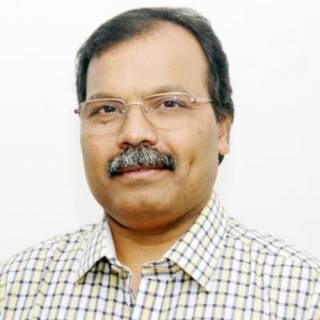Centre Principal Investigator, India. Informatics Lead and Genetics Co-ordinator:
Professor K Thangaraj
The CSIR CCMB is a government-funded basic science research institute which will deliver sequencing for the recruiting Indian sites and collaborate with UK partners in genetic analysis of Indian data.

- Clinical neuromuscular expertise, patients and geographical region
As a basic science research institute we do not see patients directly. Our clinical collaborators evaluate patients, collect samples (blood and tissue) and send them to us.
- Genetics and preclinical science expertise and facilities
CSIR-CCMB (http://www.ccmb.res.in/) is a premier research organization involved in multidisciplinary R&D programmes across scientific disciplines of biological science for economic, environmental and societal benefits of mankind. These include; Genomics & Epigenomics, Developmental Biology, Cell & Stem Cell Biology, Ecology & Wildlife Conservation, Structural Biology, Microbes and Biology of Infection. CCMB has excellent research facilities, including; next generation sequencing & genotyping, tissue culture, FACS, transgenic & gene knockout, microscopy, crystallography & NMR, etc. Dr Thangaraj has over two and half decade of expertise in the field of human genetics and made pioneering contributions in the field of population and medical genomics.
- Summary of current research programmes
Dr Thangaraj's studies, for the first time, provide evidence that the contemporary Indian populations descend from two divergent groups - Ancestral South Indians, and Ancestral North Indians (Nature, 2009) - who have admixed during the past 2,000 - 4,000 years, and for the last 2,000 years almost all populations have been practicing endogamy (American Journal of Human Genetics, 2013). Subsequently, he demonstrated that the practice of endogamy had led to a high frequency of population-specific recessive disease in India (Nature Genetics, 2017). In addition, he has mapped several novel genes that are associated with neuromuscular disorders of mitochondrial origin, cardiovascular diseases and male infertility.
- Top five publications to April '20
Shinde V, Narasimhan VM, Rohland N, Mallick S, Mah M, Lipson M, Nakatsuka N, Adamski N, Broomandkhoshbacht N, Ferry M, Lawson AM, Michel M, Oppenheimer J, Stewardson K, Jadhav N, Kim YJ, Chatterjee M, Munshi A, Panyam A, Waghmare P, Yadav Y, Patel H, Kaushik A, Thangaraj K, Meyer M, Patterson N, Rai N, Reich D (2019) An Ancient Harappan Genome Lacks Ancestry from Steppe Pastoralists or Iranian Farmers. Cell. 179:729-735.
Narasimhan VM, Patterson N, Moorjani P, Rohland N, Bernardos R, Mallick S…Thangaraj K, Kennett DJ, Frachetti M, Pinhasi R, Reich D (2019) The formation of human populations in South and Central Asia. Science. 365(6457). pii: eaat7487.
Chaubey G, Ayub Q, Rai N, Prakash S, Mushrif-Tripathy V, Mezzavilla M, Pathak AK, Tamang R, Firasat S, Reidla M, Karmin M, Rani DS, Reddy AG, Parik J, Metspalu E, Rootsi S, Dalal K, Khaliq S, Mehdi SQ, Singh L, Metspalu M, Kivisild T, Tyler-Smith C, Villems R, Thangaraj K (2017) "Like sugar in milk": reconstructing the genetic history of the Parsi population. Genome Biol. 18: 110.
Nakatsuka N, Moorjani P, Rai N, Sarkar B, Tandon A, Patterson N, Bhavani GS, Girisha KM, Mustak MS, Srinivasan S, Kaushik A, Vahab SA, Jagadeesh SM, Satyamoorthy K, Singh L, Reich D, Thangaraj K (2017) The promise of discovering population-specific disease-associated genes in South Asia. Nat. Genet. 49: 1403-1407.
Mallick S, Li H, Lipson M, Mathieson I, Gymrek M, Racimo F, Zhao M, ------------ Jorde LB, Tishkoff SA, Watkins WS, Metspalu M, Dryomov S, Sukernik R, Singh L, Thangaraj K, Pääbo S, Kelso J, Patterson N, Reich D (2016) The Simons Genome Diversity Project: 300 genomes from 142 diverse populations. Nature. 538: 201-206.
- How the new international Centre will benefit research and clinical programmes:
i. There are very few clinicians in India with specialist training in clinical diagnosis, including in diagnosis of neuromuscular disorders of mitochondrial origin. This project would offer extensive training to the clinical fellows, who would grow expertise in India.
ii. We will enable the establishment of new pipelines of next-generation sequencing data analysis.
iii. Many mutations associated with specific phenotypes in the rest of the world are often absent in India and vice versa. This collaboration would help in sharing phenotype/genotype data between centres for a better understanding of ancestry and disease.
iv. Most importantly, we envisage that this initiative will pave the way for long-term collaborations.



 Close
Close

